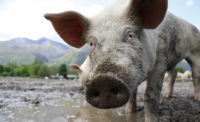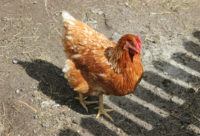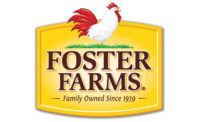An animal rights group turned over its undercover video footage to USDA showing what the activists claim are clear depictions of inhumane and disturbing treatment of hogs at a Minnesota pork processing plant that supplies Hormel Foods.
Washington, DC-based Compassion Over Killing (COK) uploaded an edited version of the graphic footage to YouTube. In the full footage the group submitted to regulatory officials, COK claims animals can be seen beaten, shocked and improperly stunned. The video also shows what appear to be pigs covered in feces and pus-filled abscesses sent down the slaughtering line. At one moment in the footage, a worker is heard saying, “if USDA is around they could shut us down.”
The facility—Quality Pork Processors (QPP) located in Austin, MN—is one of a few plants in the US that participates in the HACCP-Based Inspection Models Project (HIMP) system. The HIMP system was developed by the Food Safety and Inspection Service (FSIS) to produce a flexible, more efficient and fully integrated meat and poultry inspection system. In contrast with the traditional inspection system, HIMP places more food safety responsibilities on plant personnel with USDA inspectors focusing primarily on carcass and verification system activities. Facilities under this system are then able to operate at higher inspection speeds than others. COK says, these “excessive slaughter line speed force workers to take inhumane shortcuts that lead to extreme suffering for millions of pigs. It also jeopardizes food safety for consumers.”
But USDA doesn’t buy that the faster inspection system should be blamed. According to the Associated Press, USDA Spokesman Adam Tarr said the system is only used when the animals are sorted much further down the line.
Still, USDA says, “the actions depicted in the video under review are appalling and completely unacceptable, and if we can verify the video’s authenticity, we will aggressively investigate the case and take appropriate action.”
QPP reported it has already taken action and disciplined employees as a result of the video and is instituting significant corrective measures.
“We have reviewed the video and are very disappointed by the actions of some employees,” says Kelly Wadding, president of QPP. “The actions of these few employees don’t represent the collective culture of animal care that our employees exhibit each and every day at QPP. As such, we have taken swift and immediate action to reinforce our high standards and operating procedures in the animal care and welfare areas. We want to assure Hormel Foods and all of its customers that we care about animal welfare, and are committed to taking steps that will bring about positive changes for the industry as a whole. In addition, our Animal Welfare Council is looking at ways to exceed industry standards related to animal welfare and handling,” said Kelly Wadding, president of QPP.”
As a response to the video’s release, QPP says it is taking additional disciplinary action against some employees and will retrain all employees on proper animal handling and employee conduct. The company is also increasing review of its video monitoring and surveillance, increasing third party audits, implementing a confidential tip hotline for employees and placing humane handling officers on the plant floor to observe all animal handling. QPP will also issue a public report on its progress and additional actions in the next 30 days.
Hormel Foods says it has a zero tolerance policy for inhumane treatment of animals and conducts routine audits at all facilities. The company released a statement saying “our suppliers operate under very visible conditions, including third-party video monitoring and the USDA is present during all operations. After reviewing the edited video, we are conducting a review of processes and procedures with QPP and will ensure appropriate actions are taken.”
The footage underwent further scrutiny by the North American Meat Association (NAMI) and noted animal science professor Temple Grandin. After reviewing the video, NAMI and Grandin concluded the animals appear to have been properly stunned and insensible to pain, as required by law.
NAMI acknowledged the footage showed some rough handling of the animals that is unacceptable, but the slaughter process appeared to be working well.
“USDA inspectors are present in all slaughter plants at all times—including plants that operate under HIMP and those inspectors can take actions when they identify violations of food safety or humane handling rules. It is disingenuous to suggest that the HIMP inspection system in any way contributed to this occurrence,” NAMI says. “In addition, USDA officials identified no issues during the time period when this undercover video was shot and the company worked closely with USDA last week when the agency conducted an intensive in-plant review of the company's robust animal welfare programs.”




